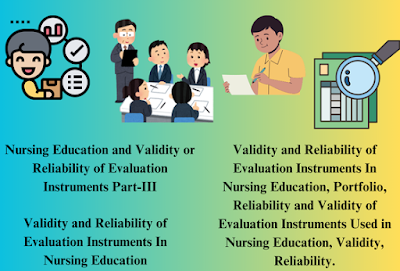Validity and Reliability of Evaluation Instruments in Nursing Education
Portfolio
A portfolio serves as a tangible collection of evidence that demonstrates program learning outcomes. It consists of various artifacts that are gathered throughout a nursing education program, such as assignments, PowerPoint presentations, concept maps, care plans, and other materials created during instructional periods. From the beginning of the program, students are provided with a guide to help them systematically collect these artifacts, ensuring that they are on the right path toward completing the portfolio successfully.
These portfolios may either be kept electronically or in a well-organized paper format. Typically, students are encouraged to include reflections for each artifact. These reflections allow students to demonstrate how each piece of work aligns with the program’s learning outcomes, further enhancing their educational experience and promoting continuous progress.
Reliability and Validity of Evaluation Instruments in Nursing Education
When using any form of an evaluation tool, ensuring the reliability and validity of that instrument is crucial. Specific procedures are required to determine these characteristics in tools used for clinical evaluations, program assessments, and tests that measure classroom achievements. These procedures are elaborated upon in other chapters, but a general overview of the key concepts of validity and reliability is offered here.
Validity
Measurement validity ensures that the evaluation tool is collecting and analyzing data relevant to what it was intended to measure. In educational settings, this involves several attributes, including relevance, accuracy, and utility (Prus & Johnson, 1994; Wholey, Haltry & Newcomer, 2004).
- An evaluation tool is relevant if it measures educational objectives as closely as possible.
- Accuracy indicates that the tool precisely assesses the educational objectives.
- Utility refers to whether the tool provides meaningful formative and summative results that can guide further evaluation and improvement.
A valid evaluation tool provides insights that are pertinent to the local program or curriculum and can guide meaningful changes (Prus & Johnson, 1994). Although various types of validity exist, measurement validity is considered a single concept.
Content-related evidence, criterion-related evidence, and construct-related evidence are categories that contribute to understanding validity, with the ideal situation being the availability of evidence from all three categories. Faculty can best evaluate the validity of an instrument when they understand the evaluation’s content, its relationship to critical criteria, and the constructs (psychological traits) the tool is measuring (Waugh & Gronlund, 2012).
- Content-related evidence looks at whether the tool appropriately represents the larger domain of behaviors or skills being evaluated. For example, in classroom settings, educators would question whether the test questions adequately represent the full range of content covered in the course. In clinical evaluations, they might ask whether the tool effectively measures the attitudes, behaviors, and skills expected of a competent nurse.
- Criterion-related evidence assesses the relationship between a score on one measure (such as a clinical performance appraisal) and other external measures. This type of evidence can be concurrent or predictive.
- Concurrent evidence refers to the correlation of one measure with another taken at the same time. For instance, if there is a high correlation between clinical evaluations and classroom exam scores, this would be considered concurrent validity.
- Predictive evidence, on the other hand, looks at how one measure correlates with another taken later on, such as course grades predicting the outcome of licensing or certification exams.
- Construct-related evidence is the relationship between a measure (e.g., a test) and student variables such as learning styles, IQ, or job experience. This evidence helps infer which factors might influence performance.
Reliability
Reliability refers to the degree to which an evaluation tool produces consistent, dependable, and precise results. It ensures that the same instrument yields similar results, even when applied to different groups of students or used by different evaluators. As described by Pedhazur and Schmelkin (1991), reliability addresses the degree to which test scores are free from errors in measurement.
There are several types of reliability:
- Stability reliability measures whether the tool yields consistent results over time, assuming the tool’s stability.
- Equivalence reliability looks at the extent to which two different forms of the same test yield similar results. For example, if a test has two versions, both should contain the same number of questions and present the same level of difficulty to ensure equivalent outcomes.
- Internal consistency reliability evaluates whether all the items in a test measure the same concept or construct. This type of reliability applies when a tool is used to assess a single concept or construct.
Since the validity of findings can be jeopardized by an unreliable instrument, it is critical that nursing faculty take steps to ensure the reliability of the evaluation tools they use.
By ensuring that evaluation instruments are both reliable and valid, nursing educators can provide accurate, fair assessments of their students, facilitating meaningful learning and fostering continued progress throughout the educational program.
